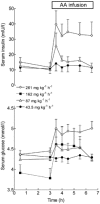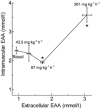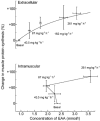Human muscle protein synthesis is modulated by extracellular, not intramuscular amino acid availability: a dose-response study
- PMID: 12909668
- PMCID: PMC2343318
- DOI: 10.1113/jphysiol.2003.050674
Human muscle protein synthesis is modulated by extracellular, not intramuscular amino acid availability: a dose-response study
Abstract
To test the hypothesis that muscle protein synthesis (MPS) is regulated by the concentration of extracellular amino acids, we investigated the dose-response relationship between the rate of human MPS and the concentrations of blood and intramuscular amino acids. We increased blood mixed amino acid concentrations by up to 240 % above basal levels by infusion of mixed amino acids (Aminosyn 15, 44-261 mg kg-1 h-1) in 21 healthy subjects, (11 men 10 women, aged 29 +/- 2 years) and measured the rate of incorporation of D5-phenylalanine or D3-leucine into muscle protein and blood and intramuscular amino acid concentrations. The relationship between the fold increase in MPS and blood essential amino acid concentration ([EAA], mM) was hyperbolic and fitted the equation MPS = (2.68 x [EAA])/(1.51 + [EAA]) (P < 0.01). The pattern of stimulation of myofibrillar, sarcoplasmic and mitochondrial protein was similar. There was no clear relationship between the rate of MPS and the concentration of intramuscular EAAs; indeed, when MPS was increasing most rapidly, the concentration of intramuscular EAAs was below basal levels. We conclude that the rates of synthesis of all classes of muscle proteins are acutely regulated by the blood [EAA] over their normal diurnal range, but become saturated at high concentrations. We propose that the stimulation of protein synthesis depends on the sensing of the concentration of extracellular, rather than intramuscular EAAs.
Figures





References
-
- Alvestrand A, Hagenfeldt L, Merli M, Oureshi A, Eriksson LS. Influence of leucine infusion on intracellular amino acids in humans. Eur J Clin Invest. 1990;20:293–298. - PubMed
-
- Bennet WM, Connacher AA, Jung RT, Stehle P, Rennie MJ. Effects of insulin and amino acids on leg protein turnover in IDDM patients. Diabetes. 1991;40:499–508. - PubMed
-
- Bennet WM, Connacher AA, Scrimgeour CM, Rennie MJ. The effect of amino acid infusion on leg protein turnover assessed by L-[15N]phenylalanine and L-[13C]leucine exchange. Eur J Clin Invest. 1990;20:37–46. - PubMed
-
- Bennet WM, Connacher AA, Scrimgeour CM, Smith K, Rennie MJ. Increase in anterior tibialis muscle protein synthesis in healthy man during mixed amino acid infusion: studies of incorporation of [1–13C]leucine. Clin Sci. 1989;76:447–454. - PubMed
-
- Bergstrom J, Fürst P, Hültman E. Free amino acids in muscle tissue and plasma during exercise in man. Clin Physiol. 1985;5:155–160. - PubMed
Publication types
MeSH terms
Substances
Grants and funding
LinkOut - more resources
Full Text Sources
Other Literature Sources

